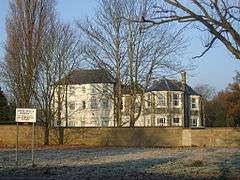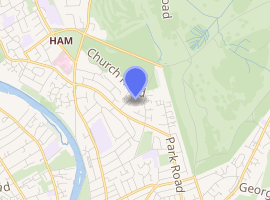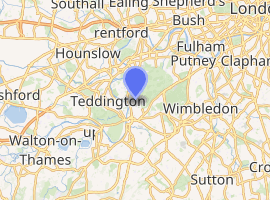Latchmere House
Latchmere House is a building and grounds adjacent to Ham Common in the Ham area of the London Borough of Richmond upon Thames, in south west London, England. Part of the site is also in the Royal Borough of Kingston upon Thames.
| Latchmere House | |||||||||||||
|---|---|---|---|---|---|---|---|---|---|---|---|---|---|
 Latchmere House looking north from Latchmere Lane | |||||||||||||

| |||||||||||||
| General information | |||||||||||||
| Architectural style | Victorian | ||||||||||||
| Address | Church Road, Ham Common, Ham, Richmond TW10 5HH | ||||||||||||
| Town or city | Ham, London | ||||||||||||
| Country | England | ||||||||||||
| Coordinates | 51.4284°N 0.2966°W | ||||||||||||
| Owner | Berkeley Homes | ||||||||||||
| Height | |||||||||||||
| Roof | slate | ||||||||||||
| Website | |||||||||||||
http://www.latchmerehouse.co.uk/
| |||||||||||||
Originally built during the Victorian era as a private dwelling, Latchmere House was then owned by the Ministry of Defence and had various uses until after World War II, when the building was transferred to Her Majesty's Prison Service. Latchmere House was then used as a detention centre and prison until it was closed in September 2011. In 2013 the site was sold to Berkeley Homes who are currently redeveloping the former prison complex into housing.
History
Originally built in the 19th century as a private dwelling, during the First World War (1914–1918) Latchmere House was used by the Ministry of Defence as a hospital for treating officers suffering from "shell shock".[1]
During the Second World War Latchmere House was used as a detention and interrogation centre (known as Camp 020) for enemy agents captured by MI5. Many members of the British Union of Fascists were held at Latchmere House during this period. They included the environmental pioneer Jorian Jenks. Over the course of August and September 1940 the BUF leaders - held without trial - were subjected to exacting interrogation techniques by military intelligence, including solitary confinement, mock executions, food deprivation and psychological torture. The interrogation exercises ended when BUF leader Sir Oswald Mosley launched legal proceedings.[2]
Britain had used torture methods at Latchmere House to extract information from German prisoners of war, and 30 rooms there had been turned into cells with hidden microphones.[3]
Latchmere House Prison
Latchmere House was transferred to Her Majesty's Prison Service in 1948. It was used as a Young Offenders Institution, remand centre, and a deportees prison before becoming a Category D men's resettlement prison in 1992.
In December 2003 a report from Her Majesty's Chief Inspector of Prisons praised Latchmere House for its rehabilitation centre, employment opportunities for inmates, and the good relationships between staff and prisoners, but noted that the prison could do more to prepare prisoners for release and that it sometimes did not quickly employ new arrivals, who might for several months be under-occupied.[4]
According to the August 2004 Prison Service Annual Report, Latchmere House's average prisoner was spending 57.6 hours every week in "purposeful activity", which made the prison "best in the country at providing useful work for its inmates."[5] The prison also did well at staff race equality and in educating its prisoners, but was not so successful at resettling prisoners or preventing drug use. All prisoner's were given the freedom to work in employment in the community, with a return curfew of between 10pm and 11pm. Though sometimes earlier due to the type of employment.
In September 2011 the Ministry of Justice closed the prison at Latchmere House and transferred remaining inmates to other prisons. The closure formed part of wider-ranging cost saving plans by the ministry.[6]
Latchmere House today
Latchmere House was sold by the Ministry of Justice to Berkeley Homes in 2013. The building constitutes prime real estate overlooking Ham Common,[7] and is expected to be redeveloped as housing with community facilities.[8]
Richmond London Borough Council applied for the main Victorian wing of the building to be listed as a site of special Architectural or Historic Interest[9] but English Heritage subsequently completed an assessment of the house and concluded that the property was not suitable for listed building status. However, Latchmere House has been designated by the London Borough of Richmond upon Thames as a ‘Building of Townscape Merit’. Both Richmond and Kingston councils have published a planning brief for the site, and development is expected to start in 2014. However, the main house and its surrounds are within the Ham Common Conservation Area, and the planning brief seeks the retention of the house and related outbuildings and the enhancement of its setting.[10]
Planning permission was granted in July 2015 to redevelop the site in to 73 new homes, including 13 affordable homes. Demolition works (including the former cell blocks) was due to commence towards the end of 2015.[11][12]
References
- Rankin, Nicholas (2009). Churchill's Wizards: The British Genius for Deception, 1914–1945. Faber and Faber. ISBN 978-0571221967.
- Thurlow, Richard (1998). Fascism in Britain. A History: 1918-1945. I.B Tauris. ISBN 1 86064 337 X.
- Cobain, Ian (2012). Cruel Britannia. Portobello Books.
- Adlam, James (12 December 2003). "Report reveals the good and the bad at Latchmere prison". Richmond and Twickenham Times. Retrieved 6 August 2012.
- "Prison keeps inmates occupied". Richmond and Twickenham Times. 13 August 2004. Retrieved 6 August 2012.
- "Two prisons to shut in efficiency bid, MoJ says". BBC News. 13 July 2011. Retrieved 6 August 2012.
- Warrell, Helen (27 October 2011). "UK prison numbers to hit new high". Financial Times. Retrieved 6 August 2012.
- Lindsell, David (10 March 2014). "A hard cell? Up-market homes plan for former Nazi interrogation prison". Richmond and Twickenham Times. Archived from the original on 26 June 2015. Retrieved 4 December 2014.
- Fleming, Christine (3 September 2011). "Latchmere House prison 'should be a listed building'". Richmond and Twickenham Times. Retrieved 6 August 2012.
- "Latchmere House Community Meeting: Frequently Asked Questions, 17 October 2012" (PDF). Royal Borough of Kingston upon Thames and London Borough of Richmond Upon Thames. Retrieved 26 January 2013.
- Proto, Laura (4 November 2014). "Halloween tour of Latchmere Prison reveals soon-to-be-gone secrets". Surrey Comet. Retrieved 9 November 2014.
- "Home – Latchmere House". Berkeley Homes. Retrieved 5 December 2015.
Further reading
- Fison, Vanessa (2018). "Rational dress and double crosses". Richmond History: Journal of the Richmond Local History Society. 39: 6–16. ISSN 0263-0958.


